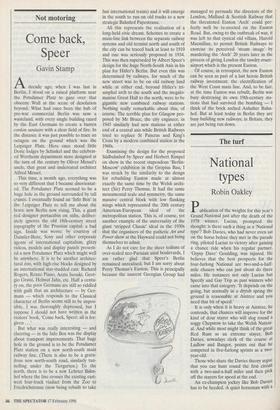Not motoring
Come back, Speer
Gavin Stamp
This time, a month ago, everything was so very different that I became disorientat- ed. The Potsdamer Platz seemed to be a huge hole in the ground surrounded by tall cranes. I eventually found an 'Info Box' in the Leipziger Platz to tell me about the brave new Berlin now rising. This, a giant red designer portacabin on stilts, deliber- ately ignores the old 18th-century street topography of the Prussian capital: a bad sign. Inside was worse; by courtesy of Daimler-Benz, Sony and other corporate agents of international capitalism, glitzy videos, models and display panels present- ed a new Potsdamer Platz which might well be anywhere. It is to be another architec- tural zoo, with high-rise blocks designed by an international star-studded cast: Richard Rogers, Renzo Piano, Arata Isosaki, Geor- gio Grassi, Helmut Jahn, etc. Half a centu- ry on, the poor Germans are still so riddled with guilt that an architecture — by Ger- mans — which responds to the Classical character of Berlin seems still to be impos- sible. I was thoroughly depressed, but I suppose I should not have written in the visitors' book, 'Come back, Speer; all is for- given ...'
But what was really interesting — and cheering — in the Info Box was the display about transport improvements. That huge hole in the ground is to be the Potsdamer Platz station on a new north-south main railway line. (There is also to be a gratu- itous new north-south road, similarly tun- nelling under the Tiergarten.) To the north, there is to be a new Lehrter Bahn- hof where the line crosses the existing east- west four-track viaduct from the Zoo to Friedrichstrasse (now being rebuilt to take fast international trains) and it will emerge in the south to run on old tracks to a new strategic Bahnhof Papestrasse.
All this represents the realisation of a long-held civic dream. Schemes to create a main-line link between the separate railway systems and old termini north and south of the city can be traced back at least to 1910 and one was seriously proposed in 1934. This was then superseded by Albert Speer's design for the huge North-South Axis in his plan for Hitler's Berlin. But even this was determined by railways, for much of the new street was to be on old railway land while at either end, beyond Hitler's tri- umphal arch to the south and the megalo- maniac Great Hall to the north, were to be gigantic new combined railway stations. Nothing really remarkable about this, of course. The terrible plan for Glasgow pro- posed by Mr Bruce, the city engineer, in 1945 similarly had new stations at either end of a central axis while British Railways tried to replace St Pancras and King's Cross by a modern combined station in the 1960s.
Examining the design for the proposed Siidbahnhof by Speer and Herbert Rimpel on show in the recent stupendous 'Berlin- Moscow' exhibition in the Gropius Bau, I was struck by the similarity to the design for rebuilding Euston made at almost exactly the same time by the Welsh archi- tect (Sir) Percy Thomas. It had the same monumental scale and symmetry, the same massive central block with low flanking wings which represented the 20th century American-European ideal of the metropolitan station. This is, of course, yet another example of the universality of the giant 'stripped Classic' ideal in the 1930s that the organisers of the pathetic Art and Power show at the Hayward could not bring themselves to admit.
As I do not care for the sheer tedium of over-scaled neo-Parisian axial boulevards, I am rather glad that Speer's Berlin remained unrealised, but I am sorry about Percy Thomas's Euston. This is principally because the nascent Georgian Group had managed to persuade the directors of the London, Midland & Scottish Railway that the threatened Euston 'Arch' could per- fectly well be re-erected on the Euston Road. But, owing to the outbreak of war, it was left to that cynical old villain, Harold Macmillan, to permit British Railways to exorcise its perceived 'steam image' by murdering the 'Arch' 20 years later in the process of giving London the tawdry ersatz- airport which is the present Euston.
Of course, in retrospect, the new Euston can be seen as part of a last heroic British railway investment: the electrification of the West Coast main line. And, to be fair, at the time Euston was rebuilt, Berlin was busy destroying its own 19th-century sta- tions that had survived the bombing — I think of the brick arched Anhalter Bahn- hof. But at least today in Berlin they are busy building new railways; in Britain, they are just being run down.


























































 Previous page
Previous page